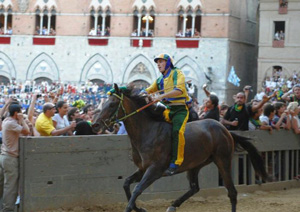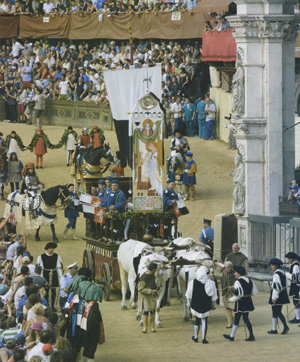The Palio: a thousand years of history
The Palio of Siena is a thousand years old but it doesn’t show it. It is certain that, if not before, in the 11th Century in Siena races called “Palii alla lunga” were run. They started outside the walls and crossed the winding streets of the walled city reaching the highest point, the old Cathedral. The prize for the race was the Pallium, a fabric of precious silk which was to give its name to the race and then the feast. From 1200 the destination of the races was moved to the church square of the New Duomo, the present one, and the Palio became the final moment of the impressive feasts of mid-August, dedicated to The Assumption of Our Holy Virgin, patron of Siena and its ancient State. Other Palios have been run in Siena, just as in other parts of Italy, to honour Saints, celebrate a military triumph or to celebrate famous people visiting the city.
 The noble knights who took part in the ancient Palios on their warrior horses run without a rider or mounted by their “putti” or “ragatii” (young lads) with picturesque names, who wore their colours. The Contrade first made their appearance in Sienese festivals during the Renaissance, parading with their allegorical floats upon which exotic or imaginary animals stood out. This is probably where the symbols and names of the seventeen Contrade came from. With the tragic and sudden end of the Republic of Siena, the Contrade became guardians of the city’s historic memory, of past grandeur and proud civic sense. The noble knights who took part in the ancient Palios on their warrior horses run without a rider or mounted by their “putti” or “ragatii” (young lads) with picturesque names, who wore their colours. The Contrade first made their appearance in Sienese festivals during the Renaissance, parading with their allegorical floats upon which exotic or imaginary animals stood out. This is probably where the symbols and names of the seventeen Contrade came from. With the tragic and sudden end of the Republic of Siena, the Contrade became guardians of the city’s historic memory, of past grandeur and proud civic sense.
In the 17th Century the races were definitely moved to Piazza del Campo, their most cherished and natural scenario, a race course, circus and theatre all in one and they run in circles for three round and slightly more than one thousand metres on the “ground in the Piazza”, that ring of tufa sand placed in the external perimeter.  Before the Palio, a historical-allegorical parade takes place. In the faraway days this was an “entourage”; during the 18th Century it included the Allegories of the Age of Enlightenment and lastly, in the late 19th Century, it became the present Historic Parade, an explicit figure commemoration of that organization, costumes and grandeur which was of the Sienese Republic, especially regarding the Contrade, which, with their participants, play the major part. Today’s Palio is played by jockeys, usually not Sienese, which ride horses that have been assigned to the Contrade by a random drawing of lots. Before the Palio, a historical-allegorical parade takes place. In the faraway days this was an “entourage”; during the 18th Century it included the Allegories of the Age of Enlightenment and lastly, in the late 19th Century, it became the present Historic Parade, an explicit figure commemoration of that organization, costumes and grandeur which was of the Sienese Republic, especially regarding the Contrade, which, with their participants, play the major part. Today’s Palio is played by jockeys, usually not Sienese, which ride horses that have been assigned to the Contrade by a random drawing of lots.
Ten Contrade participate in each Palio, according to a random drawing and alternating system dating back to 1721. The three days of the trials and the one of the race, July 2nd and August 16th, are the culminating moment of the social life of the Contrade, seventeen cities in the city. Each one has a territory, a population, a constitution, a general council, a regularly elected governing Chair, and above al, their own traditions of a social entity separate but federatedto the other “consorelle” (sister contrade). The Palio is not their occasional activity but their ultimate reason for existing. If today Siena fully lives a political, economic and social reality, totally abreast with the times, it is also true that “the Palio is run all the year round”, and it still, just as it did a thousand years ago or so, represents the city, its institutions, its values: in the end, it is to the Palio - and the Contrade which organize it and hand it down - that Siena owes its liveability, its very special social identity, its stature as a civil community.
THE PALIO IN SIENA AT A GLANCE
Where: Piazza del Campo (the main square in the town centre) in Siena
When: July 2nd and August 16th (fixed dates) |

